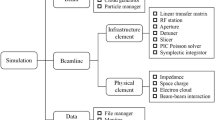Abstract
The method for construction of analytical expressions for electric and magnetic fields for some set of the distributions of the charge density is described. These expressions are used for symbolic computation of the corresponding electric and magnetic fields generated by the beam during the evolution in accelerators. Here we focus on the use of the matrix form for Lie algebraic methods for calculating the beam dynamics in the presence of self-field of the beam. In particular, the corresponding calculations are based on the predictor-corrector method. The suggested approach allows not only to carry out numerical experiments, but also to provide accurate analytical analysis of the impact of different effects with the use of ready-made modules in accordance with the concept of Virtual Accelerator Laboratory. To simulate the large number of particle distributed resources for computations are used. Pros and cons of using described approach on hybrid systems are discussed. In particular, the investigation of overall performance of the predictor-corrector method is made.
The work is supported by SPbSU 0.37.155.2014 and RFBR 16-07-01113A.
Access this chapter
Tax calculation will be finalised at checkout
Purchases are for personal use only
Similar content being viewed by others
References
Batygin, Y.K., Scheinker, A.: Suppresion of halo formation in fodo channel with nonlinear focusing. In: Proceedings of IPAC 2013. JACOW (2015)
Batygin, Y.K., Scheinker, A., Kurennoy, S.: Nonlinear Optics for Suppresion of Halo Formation in Space Charge Dominated Beams (2015)
Batygin, Y.K.: Space-charge neutralization of 750-keV proton beam in lansce injector LIN. In: Proceedings of IPAC 2015. JACOW (2015)
Ryne, R.D., Habib, S., Wangle, T.P.: Halos of Intense Proton Beams. IEEE (1996)
Paret, S., Qiang, J.: Collisional effects in particle-in-cell beam-beam simulation. In: Proceedings of IPAC 2013. JACOW (2013)
Wolfheimer, F., Gjonaj, E., Weiland, T.: Parallel particle-in-cell (PIC) codes. In: Proceedings of ICAP 2006. JACOW (2006)
Stancari, G., Redaelli, S., Moens, V.: Beam dynamics in an electron lens with the warp particle-in-cell code. In: Proceedings of IPAC 2014. JACOW (2014)
Bowers, K.J.: Accelerating a paticle-in-cell simulation using a hybrid counting sort. J. Comput. Phys. 173, 393–411 (2001). Academic Press
Makino, K., Berz, M.: COSY INFINITY Version 9. Nuclear Instruments and Methods A558 (2005)
Dragt, A.J.: Lie methods for nonlinear dynamics with applications to accelerator physics. University of Maryland (2015)
Dragt, A.J., Ryne, R.D., et al.: MARYLIE 3.0 Users Manual: A Program for Charged Particle Beam Transport Based on Lie Algebraic Methods. University of Maryland (2003)
Dragt, A.J., Ryne, R.D., et al.: Numerical computation of transfer maps using lie algebraic methods. In: Proceedings of PAC 1987 (1987)
Ryne, R.D.: Advanced computing tools and models for accelerator physics. In: Proceedings of EPAC 2008 (2008)
Andrianov, S.N.: Dynamical Modeling of Control Systems for Particle Beams’. Saint Petersburg State University, SPb (2004)
Magnuss, W.: On the exponential solution of differential equations for a linear operator. Comm. Pure Appl. Math. 7(4), 649–673 (1954)
Kulabukhova, N., Degtyatev, A., Bogdanov, A., Andrianov, S.: Simulation of space charge dynamics on HPC. In: Proceedings of IPAC 2014. JACOW (2014)
Healy, L.M., Dragt, A.J.: Concatenation of Lie algebraic maps. Lie Methods in Optics II. Lect. Notes in Physics, vol. 352 (1989)
Andrianov, S., Kulabukhova, N.: Lie algebraic methods as mathematical models for high performance computing using the multi-agent approach. In: Gervasi, O., et al. (ed.) ICCSA 2016, Part I. LNCS, vol. 9786, pp. 418–430. Springer, Heidelberg (2016)
Szilagui, M.: Electron and ion optics (in russian). Mir, Moscow (1990)
Venturini, M.: Lie methods, exact map computation, and the problem of dispertion in space charge dominated beams. Ph.D. thesis (1998)
Giovannozzi, M.: Space-Charge Simulation Using Parallel Algorithms
Bowers, K.J.: Accelerating a particle-in-cell simulation using a hybrid counting sort. J. Comput. Phys. 173, 393–411 (2001)
Qiang, J., Ryne, R.D., Habib, S., Decy, V.: An object-oriented parallel particle-in-cell Code for beam dynamics simulation in linear accelerators. J. Comput. Phys. 163, 434–451 (2000)
Kulabukhova, N.: GPGPU implementation of matrix formalism for beam dynamics simulation. In: Proceedings of ICAP 2012. JACOW (2012)
Acknowledgments
The authors would like to express gratitude to Vladimir Korkhov for valuable help. Scientific research were performed using the equipment of the Research Park of St.Petersburg State University. The work was sponsored by the Russian Foundation for Basic Research under the projects: 16-07-01113 “Virtual supercomputer as a tool for solving complex problems” and by the Saint-Petersburg State University under the project 0.37.155.2014 “Research in the field of designing and implementing effective computational simulation for hydrophisical and hydro-meteorological processes of Baltic Sea (and the open Ocean and offshores of Russia)”.
Author information
Authors and Affiliations
Corresponding author
Editor information
Editors and Affiliations
Rights and permissions
Copyright information
© 2016 Springer International Publishing Switzerland
About this paper
Cite this paper
Kulabukhova, N., Andrianov, S.N., Bogdanov, A., Degtyarev, A. (2016). Simulation of Space Charge Dynamics in High Intensive Beams on Hybrid Systems. In: Gervasi, O., et al. Computational Science and Its Applications – ICCSA 2016. ICCSA 2016. Lecture Notes in Computer Science(), vol 9786. Springer, Cham. https://doi.org/10.1007/978-3-319-42085-1_22
Download citation
DOI: https://doi.org/10.1007/978-3-319-42085-1_22
Published:
Publisher Name: Springer, Cham
Print ISBN: 978-3-319-42084-4
Online ISBN: 978-3-319-42085-1
eBook Packages: Computer ScienceComputer Science (R0)




